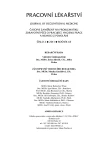Varices of lower extremities in relation to genetic factors and physical work and leisure load factors
Authors:
Š. Zelník 1; J. Buchancová 2; H. Hudečková 2
Authors‘ workplace:
ŽILPO, s. r. o., Žilina, vedúci MUDr. Štefan Zelník
1; Ústav verejného zdravotníctva JLF UK Martin, vedúca prof. MUDr. Henrieta Hudečková, PhD.
2
Published in:
Pracov. Lék., 63, 2011, No. 2, s. 87-94.
Category:
Original Papers
Overview
Varices of lower extremities are the most prevalent diseases of the venous system affecting 15–20 % of adult population. Besides acknowledged genetic factors, a lack of attention is paid to a possible impact of physical load at work and after work to the manifestation of varices.
In 2010–2011, the authors selected a group of 177 patients waiting for an indicated operation of varices of lower extremities. The sample comprised 125 women with the average age of 47.9 ± 11.2 years (x̅ ± SD) and 52 men with the average age of 38.9 ± 5.2 years with the body mass index BMI= 25.7 ± 4.5 (nonsignificant difference between men and women). Overweight and obesity (BMI over 25) was found in 48.02 % of the whole sample. 43.5% parents of patients were alse obese according to the history. The prevalence of varices was found in 145 members of the sample (81.9 %) in the family history in one or both parents. The authors followed the number of hours which participants spent during 24 hours in a horizontal, vertical and sitting position. When assessing physical load of extremities at work, 44.1 workers standing for more than 50 % of working hours had varices of the lower extremities, whereas only 19.2% workers with sedentary occupation for more than half of working hours had varices of lower extremities. Lifting loads has not shown any impact on the prevalence of varices. The authors also followed up the character and length of symptoms, number of work absences, pharmacological and other treatments during the period of operation using the method of Endovenous Laser Treatment. There were no complications after the operation in the studied sample. Concerning prevention of varices, the reduction of weight, static load of lower extremities at work are stressed which may postpone the development of varices in the predisposed individual. The authors consider important also early diagnostics and when the conservative treatment fails they suggest earlier indication of the operation of varices.
Key words:
177 patients, operation of varices with EVLT, men/women, BMI, subjective state, varices and obesity of parents, position and movement at work, 24-hours regimen, work inability, prevention
Sources
1. ASH, J. L., MOORE, C. J. Laser treatment of varicose veins: order out of chaos. Semin. Vasc. Surg., 2010, 23, s. 101–105.
2. BARROS, N., Jr., AMORIM, J. E., PEREZ, M. C. J., MIRANDA, F., Jr. Epidemiology of vulvar varicosities in pregnant women in Sao Paulo, Brazil. International Angiology, 24, suppl. 1, č. 3, s. 3.
3. BRAND, F.N., DANNENBERG, A.L., ABBOTT, R.D. et al. The epidemiology of varicose veins: The Framingham study. Am. J. Prev. Med., 1988, 4, s. 96–101.
4. HOLZEROVÁ, J. Ochorenia venózneho systému. In Hulín, I., Šimko, F. et al. Patofyziológia. Bratislava: Slovak Academic Press, 1996, s. 265–268, ISBN 80-86565-62-X.
5. JONES, R. H. Management of varicose veins. Am. Fam. Physician., 2008, 78, č. 11, s. 1289–1294. ISSN 0002 -838X.
6. KISTNER, R. L.Creating the venous vision. Abstracts the Artic Fjords Conference and workshops on chronic venous diease. 2007, Hurtigruten, 2–6 oct., n. s., dostupné na www: http://www.europeanvenousforum.org/files/arctic_f_conf/Arct_Fjords_abstr_pres.pdf
7. KRIJNEN, M. A., de BOER, E. M., BRUYNZEEL, D. P. Epidemiology of venous disorders in the general and occupational populations. Epidemiologic Reviews, 1997, 19, č. 2, s. 294–309.
8. MAZUCH, J. Klinický význam chronickej venóznej insuficiencie dolných končatín a jej patofyziológia. SK Chir., 2004, 1, č.1, s. 21–26.
9. MAZUCH, J. et al. Chirurgické aspekty chronickej venóznej insuficiencie dolných končatín. Martin: Osveta, spol. s. r. o., 2006, 187 s., ISBN 80-8063-212-X.
10. MIŠTUNA, D. Poruchy mikrocirkulácie. In Mazuch, J. et al. Chirurgické aspekty chronickej venóznej insuficiencie dolných končatín. Martin: Osveta, spol. s. r. o., 2006, s. 31–33, ISBN 80-8063-212-X.
11. NEGLÉN, P. How accurate are our diagnostic tests for reflux and obstruction? Abstracts the Artic Fjords Conference and workshops on chronic venous diease. Hurtigruten, 2007, 2007, dostupné na www: http://www.europeanvenousforum.org/files/arctic_f_conf/Arct_Fjords_abstr_pres.pdf
12. NAMBIAR, R. The incidence of varicose veins in Singapore (a study in three occupational groups). Singapoure Medic. Journal, 1968, 9, č. 3, s. 1–3.
13. TOMEI, F., BACCOLO, T.P., TOMAO, E., PALMI, S., ROSATI, M. V. Chronic venous disorders and occupation. Amer. J. Indust. Med., 1999, 36, č. 6, s. 653–665.
14. TOPORCER, T., LAKYOVÁ, L., RADOŇAK, J. Venózny ulkus – súčasné pohľady na etiopatogenézu, diagnostiku a terapiu. Čas. Lék. čes., 2008, 147, č. 4, s. 199–205.
15. TÜCHSEN, F. et al. Prolonged standing at work and hospitalisation due to varicose veins: a 12-year prospective study of the Danish population. Occup. environ. Med., 2005, 62, č. 12, s. 847–850.
16. ZELNÍK, Š. Operačná liečba s použitím endovenózneho lasera. Problém varixov. Medical practice, 2006, 1, č. 7–8, s. 26.
17. Nariadenie vlády SR č. 181/2006 o minimálnych bezpečnostných a zdravotných požiadavkach pri ručnej manipulácii s bremenami z 19. 4. 2006.
Labels
Hygiene and epidemiology Hyperbaric medicine Occupational medicineArticle was published in
Occupational Medicine

2011 Issue 2
Most read in this issue
- Professional isthmus lesions of nervus ulnaris in the elbow – anatomical, physiological principles, pathogenesis
- A occupational preventive health care of workers at risk of cytostatic drugs in the Faculty Hospital Hradec Králové
- Varices of lower extremities in relation to genetic factors and physical work and leisure load factors
- Detection of 1-hydroxypyrene in urine of a coke plant workers
